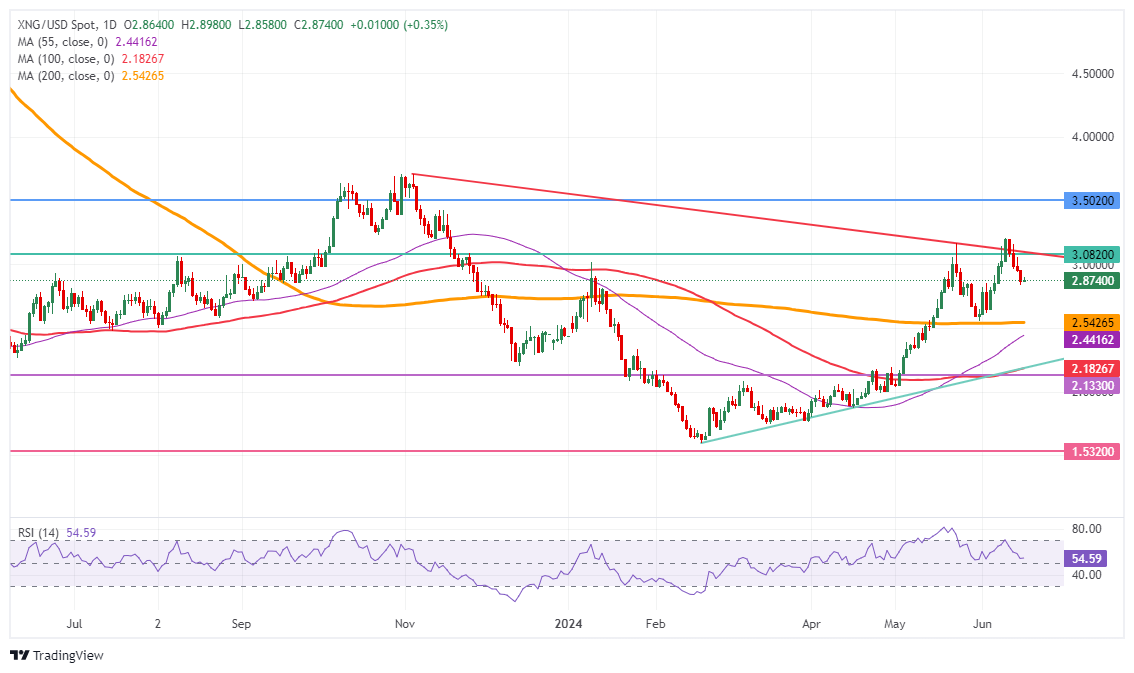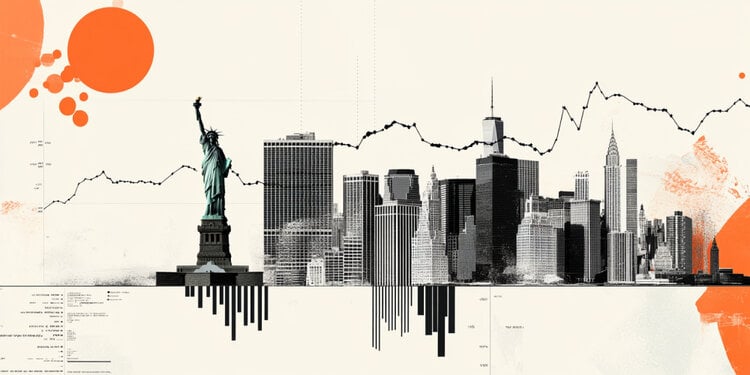- Gas Natural tries to break its four-day losing streak on Tuesday.
- Traders evaluate various data, while European gas warehouses are at 73.41% of their capacity.
- The US Dollar Index is trading a little higher after its lower performance on Monday.
The price of Natural Gas (XNG/USD) is virtually flat on Tuesday, holding above the $2.80 level as it attempts to avoid a five-day losing streak. The easing of pressure on the price of the energy commodity comes after Israel’s Prime Minister Benjamin Netanyahu dismantled his war cabinet and convoys of humanitarian aid were allowed into the Gaza region on Monday. This defuses a period of tension in the region since October 10, 2023, when Hamas attacked the Israeli music festival.
Meanwhile, the US Dollar Index (DXY), which tracks the value of the dollar against six major currencies, started the week on the wrong foot, although it is slightly in the green ahead of US retail sales data for May, which will be posted later in the day. Markets are starting to reduce European election risk and are starting to focus again on US data. Elsewhere, there are no less than six US Federal Reserve (Fed) speakers scheduled for this Tuesday , so the Dollar is set to face some substantial moves.
Natural Gas is trading at $2.87 per MMBtu at the time of writing.
News and drivers of the Natural Gas market: Difficult to choose which data point counts
- According to Bloomberg data, the combined Liquefied Natural Gas (LNG) warehouses in Europe are almost 73.41% full, returning to levels from mid-January of this year.
- Shell Plc will buy LNG trader Pavilion Energy from Singapore state-owned Temasek Holdings. Pavilion Energy trades and ships LNG in Asia and Europe, Reuters reports.
- The flow of Norwegian gas to Europe has returned to normal after a series of unforeseen interruptions, Gassco tells Bloomberg.
- Var Energi and VNG extend their collaboration for another 12 years, with Var Energi agreeing to deliver 5 billion cubic meters of LNG to VNG, Bloomberg reports.
Technical Analysis of Natural Gas: Europe’s reserves on the way
Natural Gas prices are expected to relax further despite traders’ efforts to maintain XNG prices at current levels. With European gas warehouses on track to fill in time when the heating season begins, the risk of sluggish demand could prevail. Add to this the easing of tensions in the Middle East, and the near-term outlook for LNG looks bleak.
The crucial level near $3.08 (March 6, 2023 high) remains key after its false breakout last week. Additionally, the red descending trend line at $3.10 will also weigh on this area as a boundary. Higher up, the new year-to-date high at $3.16 is the level to beat.
On the downside, the 200-day SMA acts as the first support near $2.54. If that support area does not hold, the next target could be the crucial level near $2.14, with intermediate support by the 55-day SMA near $2.44. Further down, the major support lies at $2.18 with the 100-day SMA.
Natural Gas: Daily Chart
Natural Gas FAQs
The dynamics of supply and demand is a key factor that influences Natural Gas prices, and in turn is influenced by global economic growth, industrial activity, population growth, production levels and inventories. Climate influences Natural Gas prices because more Gas is used during cold winters and hot summers for heating and cooling. Competition from other energy sources influences prices as consumers may opt for cheaper sources. Geopolitical events, such as the war in Ukraine, also play a role. Government policies related to extraction, transportation and environmental issues also influence prices.
The main economic publication that influences Natural Gas prices is the weekly inventory bulletin of the Energy Information Administration (EIA), a US government agency that produces data on the gas market in the United States. The EIA Gas bulletin usually comes out on Thursday at 14:30 GMT, the day after the EIA publishes its weekly Oil bulletin. The economic data of the large consumers of Natural Gas can influence supply and demand, among which China, Germany and Japan stand out. Natural gas is primarily priced and traded in US dollars, so economic releases affecting the US dollar are also factors.
The US dollar is the world’s reserve currency and most commodities, including Natural Gas, are quoted and traded in international markets in US dollars. Therefore, the value of the Dollar influences the price of Natural Gas, since if the Dollar strengthens, fewer dollars are needed to buy the same volume of gas (the price falls), and vice versa if the dollar strengthens.
Source: Fx Street
I am Joshua Winder, a senior-level journalist and editor at World Stock Market. I specialize in covering news related to the stock market and economic trends. With more than 8 years of experience in this field, I have become an expert in financial reporting.








